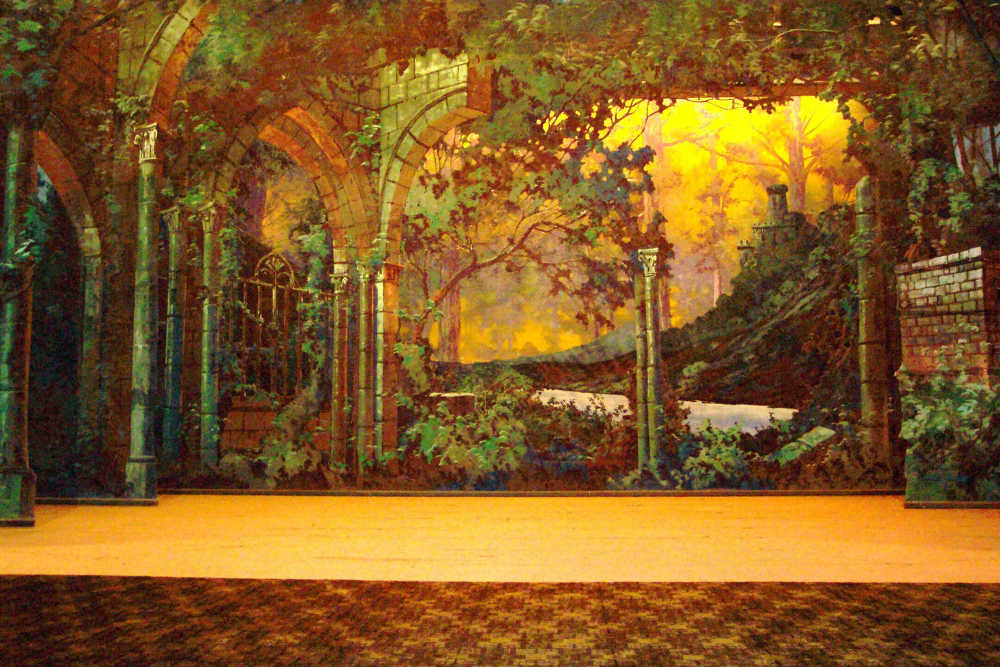Temple's unique backdrops set the stage for traditions, fanfare

A Scottish setting with King Robert the Bruce's castle in the background; several chamber settings; a ruined city similar to King Solomon's Temple; a Roman portico showing a lake and buildings; an Egyptian Sphinx -- these are the wonders that hang in Fort Scott's Scottish Rite temple -- stunning stage backdrops that transport the viewers into other times and places.
The auditorium at the Scottish Rite Temple, 110 S. Main, houses 108 handpainted backdrops. Since it takes three to five backdrops to create one complete scene, the 108 backdrops work together to create 49 different sets depicting scenes from around the world, a treasure room, outdoor and many others.
The century-old drops were painted in 1904 by artist Thomas G. Moses. Born in Liverpool, England, in July 1856, he traveled the United States, painting scenery for theaters and Masonic Temples. He also became an accomplished landscape painter. According to Scottish Rite Temple executive secretary Keith Jeffers, Moses also painted for about 30 other Shrine Temples, in addition to painting backgrounds for many movies, such as the original "20,000 Leagues Under the Sea, and for several Broadway plays. The Internet Broadway database credits him with set design for seven plays at around the turn of the century. His works appeared in more than 40 states, in theaters and opera houses in the nation.
Many believe Moses' work in Masonic Temples was his greatest work.
"The mere existence of these beautifully designed and painted large canvases gives the theater historian great insight into a time and craft that has long passed, as well as providing elaborate scenes of antiquity that still enriche degree presentations today," says C. Lance Brockman's "Thomas G. Moses Profile of a Scenic Artist," excerpted from "Heredom," the transactions of the Scottish Rite Research Society, found at www.scottishrite.org.
By using several drops to create one scene, Moses was able to give the scenes a three dimensional appearance. His creativity provided the scenery with special effects such as doors that will disappear and reappear, depending on the lighting. Some of the scenery has been accented with pieces of aluminum foil which allow the sets to sparkle in different places.
Moses' development of an impressionist plein-air style of gouache painting makes his backdrops come to life. Plein-air paintings are taken directly from nature and are infused with a feeling of the open air. Gouache is a thick, opaque watercolor pigment, sometimes called body color, that produces a more vividly colored picture than a typical watercolor.
In 1924, Moses returned to Fort Scott to increase the paintings' widths from 40 feet wide to 50 feet wide by painting an additional five feet onto each side. This addition was made in an effort to make the backdrops a better size to fit the stage in the Temple, Jeffers said. Moses was in his 70s at the time.
According to a biography of Moses, he continued to paint scenery until 1932.
The backdrops are used at the Temple primarily to demonstrate the different degrees of the Scottish Rite Masons. Sometimes the Scottish Rite is called the College of Freemasonry, because of its use of drama to teach moral lessons to its Masons. These dramatic allegories are one-act plays, which utilize Moses's backdrops in addition to period costumes, in order to leave a lasting impact on the Masons. According to a Scottish Rite Web site, www.scottishritecalifornia.org, these degrees represent historical principles.
"The Scottish Rite Degrees give us a sense of historical values and standards. Today is the child of yesterday, and no one can understand the significance of the epochal events that are shaking the world unless he sees them from the vantage point of history. Out of the crises of the past, man has discovered principles that are as solid as the mountains, as enduring as the stars," the Web site said.
Moses' backdrops to enhance the degrees illustrated to the young Masons, enabling them to retain more of the information taught. According to Jeffers, masonic author Albert Pike, who wrote "Morals and Dogma of the Ancient and Accepted Rite of Freemasonry," said men learn more by seeing than by hearing.
Moses' scenes not only enhance the degrees conducted by the Scottish Rite Masons, they also serve as backdrops and scenery for special occasions such as weddings, Jeffers said.
Jeffers said the 108 priceless drops are stored carefully in the Scottish Rite Temple. They have never been rolled up; they have always been stored in a hanging fashion, directly above the stage.
This storage method not only helps to preserve the paintings, but it allows for easy backdrop changes, Jeffers said.
